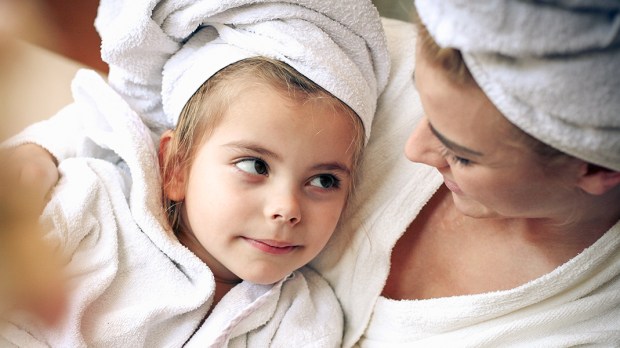Teaching modesty is missing in the education of children today. Beatrice Bergeras, a wife and a mother of seven children and trained in counseling teenagers, holds a master’s degree from the John Paul II Institute in Rome and is the founder of the “Loving can be learned” (“Aimer, ça s’apprend”) association. In an interview, she said that modesty, when taught from an early age, helps build up the person, and makes him or her capable of self-giving afterwards.
Here’s more of what she has to say on the subject:
Aleteia:How do you define modesty?
Beatrice Bergeras: Father Guy Pagès wrote that “modesty is the natural virtue that hides from curiosity what belongs to the intimacy of the person.” All of the words there are important! When I talk to little ones, I tell them that modesty is natural andthat it belongs to our nature as a man or a woman, without necessarily speaking of virtue, but rather of habits. And I tell them that modesty can be learned.
As for curiosity, I point out that there are two kinds: the natural one that we have regarding ourselves or others, which is of the order of knowledge, of ourselves or of the other. And then there is the less natural curiosity, of the order of indiscretion, an unhealthy curiosity that goes against modesty.
Intimacy is the deep heart of the human person. It’s his “secret garden,” where Christians recognize the soul, the center of the will enlightened by intelligence. And a human person is set apart from animals by intelligence, will, memory and consciousness, and the ability to perceive the True, Beautiful, and Good. He is created in the image and likeness of God, and has the ability to enter into relationships with others, to love them. The person also has the power to enter into a relationship with God. God created man out of love and to love, and so man cannot live without loving or being loved.
People tend to define modesty strictly as a way of dressing.Isn’t it more than that?
Yes, we often associate modesty with dress, but this is just an outward expression — modesty is much broader than that. The need to focus on how we dress exists only because our gaze is perverted, because we look at others no longer with the goal of living a relationship of friendship or love, but to profit selfishly from them. The characteristic of true love is to be able to give oneself totally to the other, in all the dimensions of one’s person, and not to use the other as an object for one’s selfish pleasure.
What is the point of teaching modesty to children and adolescents?
The point is “to awaken them to respect for the human person.” It’s to make them grow towards the True, the Beautiful, and the Good all at the same time, while remaining unified: modesty keeps the body from being separated from the soul. Modesty is at the border between the two and acts as a protection of the intimacy of the person. Children will grow into the truth of love, the beauty of the body and of love, and the good, in the sense of building themselves up first, then their capacity to give themselves in true love afterwards. The stakes are huge!
Modesty is directly related to the learning of love, through self-esteem, self-control, the understanding and integration of otherness, purity, and chastity. Modesty leads us to look at ourselves, and the more a child understands in his heart the respect that he is owed as a person, the more modest he will be and the more he will be capable of an interior life. It’s only in the heart of a unified person that a true love can be born. For a Christian life, being able to go inside oneself is also the beginning of a life of prayer.
From what age can one inculcate modesty?
Modesty must arise naturally and can manifest as early as age 3 to 4. While it has to be accompanied and encouraged, it should not be imposed. Before age 2, the child discovers his own body and feels no embarrassment at exposing his nakedness. He discovers his body and the sensations associated with certain touches but there is no immodesty: he is just curious, and it’s a healthy curiosity!
At around 3 or 4 years of age, a child with “typical” development begins to be curious about others. He may compare his body with that of his brothers and sisters in the family setting and that of his peers of the same age. This is the age when he really becomes aware of the difference between the sexes, and starts to ask questions. He must be answered with appropriate words, but we should avoid coarse or childish expressions. He must marvel at the beauty of the body! If we imply that there is something dirty behind these subjects, that will remain in his memory.
Starting around the age of 4, he begins to open up more to the universe of the other and become aware of his own identity. It’s during this period that modesty appears. Starting around 6-7 years old, but possibly earlier, the child becomes more and more modest. He understands what intimacy is and knows how to respect the limits between himself and others. This discovery of modesty is directly related to the consciousness of being a person in his own right. The child makes the connection more or less consciously between his body and his heart.
How can we make a young child aware of his uniqueness?
When I get involved in primary school classes, I always bring along a pretty Russian matryoshka doll, and I explain that we see the doll outside but not the ones inside. It helps young children understand what a person is in all its dimensions: bodily, emotional, intellectual, and emotional. (At first, I leave the social dimension aside.)
The main idea is to show them that modesty is linked to the notion of the person. I ask them what the first thing is that they will look for in the body of someone they meet for the first time, and what will give them information about who that person really is. In other words, I ask what the most personal part of the human body is, what reveals the soul. Even the little ones immediately find the right answer: it’s the face! And in the face, the eyes, the gaze! The gaze reveals the soul. I emphasize that conversely, the knee or foot expresses nothing personal.
And with teenagers?
We can go further by pointing out that certain parts of the body suggest sexual pleasure, and that exposing them is an invitation to “genitality” rather than to a relationship of love. That’s why we naturally hide our genitals.
With teens, I use the ads that we are flooded with that show women with practically nothing on, and I ask them if the effect would be the same if the face of the woman of the advertisement was that of their mother. Obviously, the effect is not the same, because their mother is a person they know and love. In this situation, or in others that they themselves have experienced of an intrusion into their privacy, I invite them to tell me what their immediate reaction was. They all answer me without exception that they felt a sense of shame: this rupture of unity can provoke in a child, as in an adult, beyond shame, a feeling of guilt and a very deep disturbance.
There is also an anecdote that I tell the teenagers: the experience lived by prisoners in the Nazi camps, but elsewhere too. What was done to remove the prisoners’ dignity? The were forced to undress! They were thus reduced to the rank of an animal. Animals do not have modesty.
How can we help children to unify body, heart, and mind?
We must help them to return to themselves, to listen to their bodies and their hearts. The best way is surely silence. This generation often ignores inner silence. We live in a society of permanent noise. It’s a very good exercise to ask them to spend moments in silence — not necessarily very long ones — because it’s only in their deepest heart that they will discover what their true desires are and that they will be able to make free choices.
In the case of older teens, I ask them to think about how they want to be treated: do they want to be respected in their human dignity, or would they accept being reduced to an impersonal object? The whole question is there, and modesty is the best tool to prevent the body from being separated from the soul, for acts to be separated from the intention. It’s very disturbing for me to see this disunity in some young girls, this separation that they make between their body and their interiority. As a result, the think that the acts they engage in, including sexual intercourse, have no impact on their interiority. But any act done, whatever it is, necessarily has consequences on our whole being.

Read more:
10 Tips on how to build healthy self-esteem

